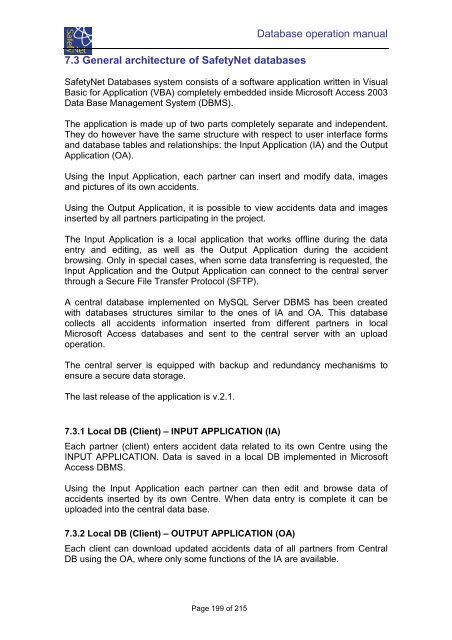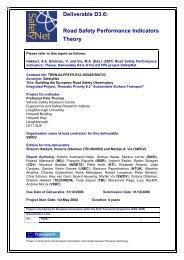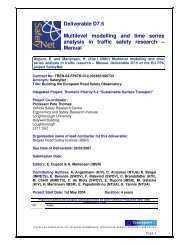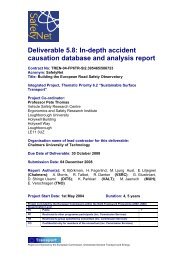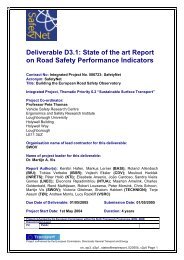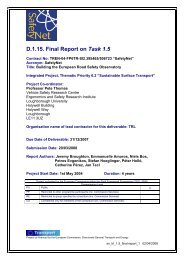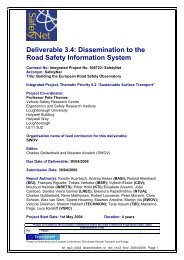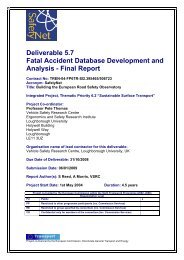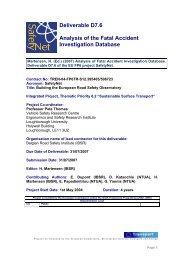Glossary of Data Variables for Fatal and accident causation ... - ERSO
Glossary of Data Variables for Fatal and accident causation ... - ERSO
Glossary of Data Variables for Fatal and accident causation ... - ERSO
Create successful ePaper yourself
Turn your PDF publications into a flip-book with our unique Google optimized e-Paper software.
7.3 General architecture <strong>of</strong> SafetyNet databases<br />
<strong>Data</strong>base operation manual<br />
SafetyNet <strong>Data</strong>bases system consists <strong>of</strong> a s<strong>of</strong>tware application written in Visual<br />
Basic <strong>for</strong> Application (VBA) completely embedded inside Micros<strong>of</strong>t Access 2003<br />
<strong>Data</strong> Base Management System (DBMS).<br />
The application is made up <strong>of</strong> two parts completely separate <strong>and</strong> independent.<br />
They do however have the same structure with respect to user interface <strong>for</strong>ms<br />
<strong>and</strong> database tables <strong>and</strong> relationships: the Input Application (IA) <strong>and</strong> the Output<br />
Application (OA).<br />
Using the Input Application, each partner can insert <strong>and</strong> modify data, images<br />
<strong>and</strong> pictures <strong>of</strong> its own <strong>accident</strong>s.<br />
Using the Output Application, it is possible to view <strong>accident</strong>s data <strong>and</strong> images<br />
inserted by all partners participating in the project.<br />
The Input Application is a local application that works <strong>of</strong>fline during the data<br />
entry <strong>and</strong> editing, as well as the Output Application during the <strong>accident</strong><br />
browsing. Only in special cases, when some data transferring is requested, the<br />
Input Application <strong>and</strong> the Output Application can connect to the central server<br />
through a Secure File Transfer Protocol (SFTP).<br />
A central database implemented on MySQL Server DBMS has been created<br />
with databases structures similar to the ones <strong>of</strong> IA <strong>and</strong> OA. This database<br />
collects all <strong>accident</strong>s in<strong>for</strong>mation inserted from different partners in local<br />
Micros<strong>of</strong>t Access databases <strong>and</strong> sent to the central server with an upload<br />
operation.<br />
The central server is equipped with backup <strong>and</strong> redundancy mechanisms to<br />
ensure a secure data storage.<br />
The last release <strong>of</strong> the application is v.2.1.<br />
7.3.1 Local DB (Client) – INPUT APPLICATION (IA)<br />
Each partner (client) enters <strong>accident</strong> data related to its own Centre using the<br />
INPUT APPLICATION. <strong>Data</strong> is saved in a local DB implemented in Micros<strong>of</strong>t<br />
Access DBMS.<br />
Using the Input Application each partner can then edit <strong>and</strong> browse data <strong>of</strong><br />
<strong>accident</strong>s inserted by its own Centre. When data entry is complete it can be<br />
uploaded into the central data base.<br />
7.3.2 Local DB (Client) – OUTPUT APPLICATION (OA)<br />
Each client can download updated <strong>accident</strong>s data <strong>of</strong> all partners from Central<br />
DB using the OA, where only some functions <strong>of</strong> the IA are available.<br />
Page 199 <strong>of</strong> 215


